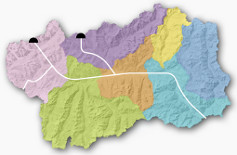The Champorcher Valley
How: by car.
Recommended duration: a day.
Recommended period: all year round.
Length: about 20 km.
An itinerary to discover the Lower Aosta Valley, following the trail of the Roman road and the wild and wide Champorcher Valley: an area of unexpected and primitive beauty that reveals itself among cascades and rivers, outlined by old bridges and centuries-old chestnut trees.
Once you go past the border with nearby Piedmont, marked out on the left by the geometrical profile of the thirteenth century Tour de Pramotton, the southernmost of the Aosta Valley fortresses, you will enter Pont-Saint-Martin, a hamlet which has developed around the spectacular bridge from the Roman period (1st century B.C.) that spans the Lys river. The hamlet is also dominated by the remains of the so-called Castellaccio, whose original nucleus dates back to the eleventh century and which also includes a beautiful Romanesque chapel dedicated to Saint Martin. Ascending in the direction of Perloz, you will reach the beautiful chapel of Fontaney, a reduced-scale reproduction of Aosta Cathedral. Along the road, looms the elegant Baraing Castle, which was built at the end of the 14th century in neo-Gothic style and has recently been restored. It is currently the headquarters of the Mountain Community.
You can then continue along the trunk road in the direction of Aosta, skirting the terraced hill where vines are cultivated and you will reach the village of Donnas, an old hamlet that emerges on the route of the Roman road of the Gauls, which still stands as a testimony to the extraordinary paved section carved in the rock and marked by the passing of carts over the centuries. It is visible from the western exit of the village: it is more than 200 m long and has an archway that has been conserved in the original rocky slope and just beyond, there is a milestone with the inscription ‘XXXVI’, which corresponds to the number of Roman miles that separate this hamlet from Aosta ( Augusta Praetoria ). The medieval hamlet opens up to the east with an ancient gateway and winds along up to the charming chiesetta di Sant’Orso (little church of Saint Orso) which was built on the exact location of the Roman road; the centre is dotted with old houses, some of them bearing noteworthy architectural features, such as refined arched mullioned windows and cross-windows (15th-16th centuries). In the centre you can also admire the seventeenth century Palazzo Enrielli, which is characterised by its cylindrical tower, and the Casatorre del Borgo, which is currently the seat of the Music Institute.
We cannot hide the fact that Donnas is part of the National Association of Wine Cities that includes more than 500 Municipalities dedicated to wine growing. It is the land of the production of DOC ‘Donnas’ red wine and in order to pass on the knowledge and history of winemaking traditions used since the 13th century, some winegrowers joined together in 1971 to form the cooperative Les Caves, namely the wine cellars, with the aim of protecting and guaranteeing the quality and authenticity of their wines. The first seat of the Caves, a building dating back to the late nineteenth century with beautiful brick vaults, now houses the Wine Ecomuseum, whose tour route follows the cycle of the seasons and the different stages of work of the lives connected to them.
Still continuing in the direction of Aosta you will come across Bard, which is dominated by the rocky promontory on which the homonymous fortress stands, which can be visited and which is now the seat of the Museum of the Alps. Due to its strategic position with control over transits, Bard Fort must have been the site of fortified settlements already in prehistoric times (Bronze Age and Iron Age); the first historical evidence that testifies to the presence of a fortified site dates back to the early 11th century. Property of the noble lords of Bard until the 13th century, the fort then passed on to the House of Savoy and between the 17th and 18th centuries it was reinforced and enlarged for military purposes. After the memorable attack inflicted by Napoleon’s troops on the night of May 21, 1800, the fort was first razed to the ground and then rebuilt by Carlo Felice of Savoy. In the village of Bard, which just like Donnas, grew along the Roman road, you can see some monumental homes dating back to the 15th-16th centuries ( Challant House, Bishop’s House, Valperga House, Sundial House and Maison Nicole ). At Bard you will also find an interesting geological site, in which one can observe the ‘Pots of the Giants’ (cylindrical cavities formed by the explosive power of water full of debris), erratic boulders and roches moutonnées (sheepbacks) bearing interesting rock engravings (2nd millenium B.C.).
By crossing the beautiful bridge that dates back to the Late Middle Ages and spans the Dora river, one reaches the village of Hône, a true flatland counterpart to Fort Bard, from which the Champorcher Valley starts. At Hône, recent archeological digs carried out on the site of the parish church of Saint George, revealed the presence of stonework of at least three earlier churches; the current transparent floor allows one to see the most significant parts of these structures brought to light by the excavations.
Taking the ascent you will reach Pontboset, once you have crossed the Ayasse river which at this point has carved the rock for centuries, creating a deep, wild and steep gorge among smooth rocks, boulders and dense woods of chestnut trees. As its name suggests, this is a place that is distinguished by numerous and characteristic bridges, that are mostly ‘humpbacked’ and date back to the Late Middle Ages and connect the two banks of the river. The parish church, dedicated to Saint Grato, dates back to the 17th century and it seems that it was built on the place where a smaller chapel used to stand; until that time the inhabitants of Pontboset were obliged to go to Hône to attend services.
By continuing onwards you will reach the municipality of Champorcher, a winter sports resort that offers the chance to go on wonderful walks during the summer season, as it is part of the Mont-Avic Regional Park and on the boundary with the Gran Paradiso National Park.
On the rocky promontory at the start of the village one can admire the square tower, remains from the very old castle, it was completely rebuilt in 1320; on this same high point stand the church and the bell tower. The traditional artisan activity of this valley is the spinning and weaving of hemp. In the hamlet of Chardonney you can visit the permanent exhibition, where one can see the old looms and admire the products of this process and visit the Hemp Ecomuseum where one can relive the atmosphere of a evening of spent at the loom as in times gone by.













